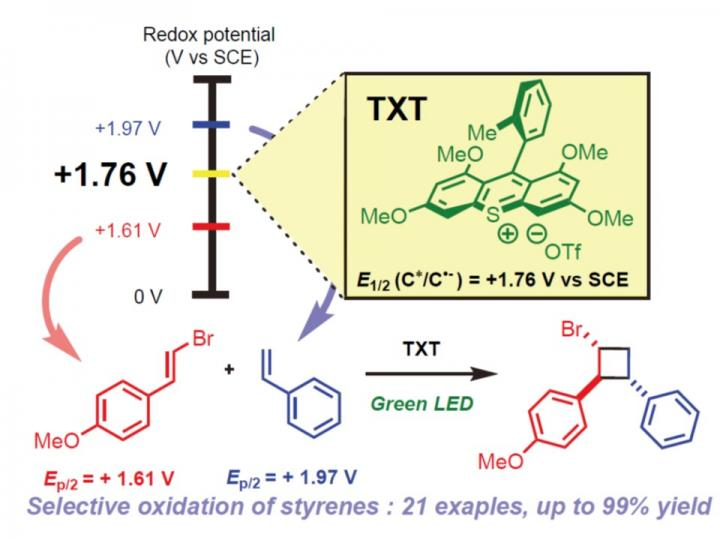Aug 4 2020
A research group from Japan has formulated a light-based reaction that provides high numbers of the base chemical component needed to synthesize bioactive compounds that are utilized in regular industrial products.
 The picture illustrates the redox potential controlled selective oxidation of styrenes for regio- and stereoselective crossed intermolecular [2 + 2] cycloaddition via organophotoredox catalysis. Image Credit: Yujiro Hoshino, Yokohama National University.
The picture illustrates the redox potential controlled selective oxidation of styrenes for regio- and stereoselective crossed intermolecular [2 + 2] cycloaddition via organophotoredox catalysis. Image Credit: Yujiro Hoshino, Yokohama National University.
The study findings were reported in the Organic Letters journal on June 11th, 2020.
We developed a redox potential-controlled and cost-effective method to synthesize multisubstituted cyclobutanes, which are present in the core structure of various products and bioactive components.
Yujiro Hoshino, Study Author and Research Associate, Yokohama National University
Using cycloaddition reaction, researchers can synthesize heterocyclic and carbocyclic organic compounds with atom-efficiency. Photocycloadditions of olefins such as styrenes have long been performed by treating them with transition metal catalysts, which are toxic and high-cost chemical reagents, or by using high-energy ultraviolet light. Olefins are chemicals used to produce rubber and plastics.
Most importantly, the reaction offers homo-dimers and not hetero-dimers. Moreover, the powerful light destroys the bonds that hold the chemical together, thereby enabling it to disintegrate and form again into a new configuration called cyclobutene ring.
Redox potential is the term used to describe how readily a chemical gains or loses electrons. Hoshino and his collaborators leveraged this feature and used a green, visible light to irradiate styrenes positioned in a two-by-two arrangement.
This treatment enabled the chemical bonds and components to optionally reorganize as the light liberated the electrons from the styrenes. The newly arranged chemical components were multisubstituted cyclobutanes.
By focusing on the different redox potential between various styrenes and optimizing our light catalysts, we developed a mild and clean method to synthesize multisubstituted cyclobutanes.
Kenta Tanaka, Study First Author and Assistant Professor, Tokyo University of Science
“Emphasis will be placed on the strategy which shows the potential to synthesize multisubstituted cyclobutanes via radical cation species without any transition metal catalysts,” stated Kiyoshi Honda, another corresponding author of the paper and a professor at Yokohama National University.
As a next step, the team intends to extend the use of different visible-light catalysis techniques.
We hope our reaction system provides an efficient and new method for green-light-driven organic chemical reactions, and that we continue to contribute to the field.
Yujiro Hoshino, Study Author and Research Associate, Yokohama National University
This study was financially supported in part by the Nanotechnology Platform Program at the Ministry of Education, Culture, Sports, Science, and Technology in Japan and Yokohama National University.
Journal Reference
Tanaka, K., et al. (2020) Redox Potential Controlled Selective Oxidation of Styrenes for Regio- and Stereoselective Crossed Intermolecular [2 + 2] Cycloaddition via Organophotoredox Catalysis. Organic Letters. doi.org/10.1021/acs.orglett.0c01852.